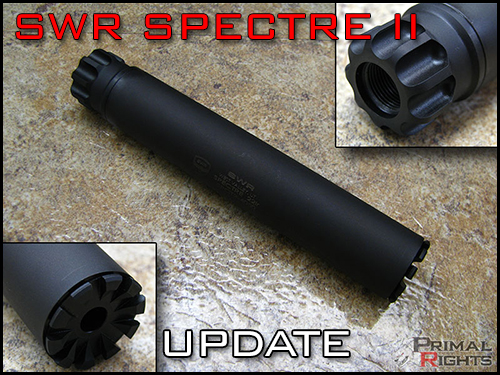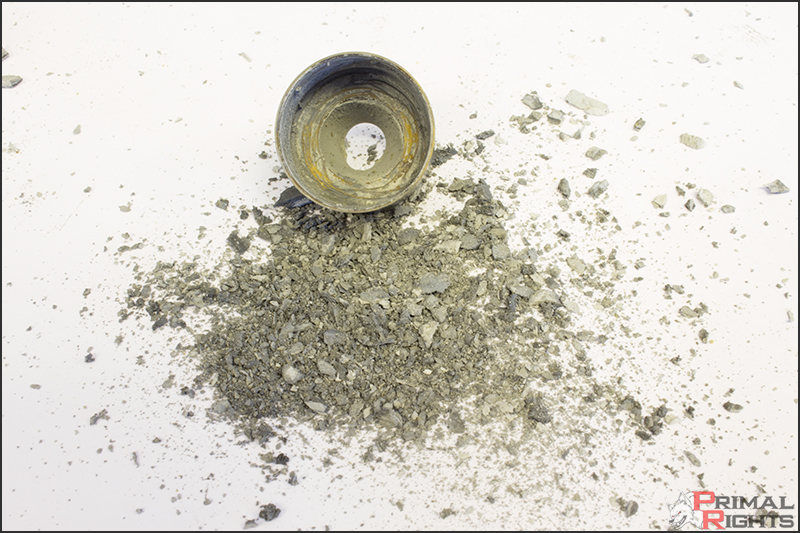
Most product reviews are done with new items, which are then used a little bit to get a feel for the product. The review is concluded with whatever conclusions which can be drawn from the usually limited testing, and is not revisited after time has passed. More importantly, most reviewers move on to other products once the review has been concluded, and fail to get any further experience with that item. As most of you are aware, that is not the case with Primal Rights. The items we review are used heavily during the entire review process, and even more afterward. Today we're going to revisit the SWR Spectre II which was reviewed earlier this year.
One of our primary concerns with rimfire suppressors is their serviceability. Most rimfire ammo, and specifically most 22lr ammo, is exceedingly dirty. The powders used are quite dirty, and the bullets themselves leave lead deposits along the entire interior surface of the suppressor. It does not take more than a couple thousand rounds of some excessively dirty ammo to start filling the suppressor up, which results in shots being louder. Why they get loud is a combination of factors. The first factor being the reduced internal volume caused by the buildup of solids. The smaller the container, the less efficient it will be at handling escaping gasses. The second factor would be the design of the baffles being hindered by the buildup of solids. Where curves exist to slow and direct gasses, become plugged or modified as the solids build up on top of them. There are other factors, which are more complex, but those are the two primary symptoms which lead to a suppressor being louder than it should.
As I mentioned in the first review of this suppressor, the SWR Spectre II is designed specifically to combat the above symptoms. In that review, we showed what the suppressor looked like after a few hundred rounds. While that is certainly noteworthy, a much higher round count was required to truly appreciate how much of a leader this suppressor truly is.
At the time of the pictures below, the suppressor had between 3,000 and 3,500 rounds through it. Primarily Wolf MT and CCI Subsonic HP's, with a few other types thrown in there. I was expecting to be able to open the suppressor with the supplied tool, but I did not expect it to come apart so easily. The end cap unscrewed effortlessly, and the baffle stack literally fell out onto the bench. Below, you see the baffle stack exterior, being completely clean.

Keep in mind the excessively high round count. I can only think of one other suppressor which would be this easy to take apart after so many rounds had been fired, and that is the SilencerCo Sparrow. However, it's worth noting that the Sparrow is extraordinarily loud on the first shot, with subsequent shots being quieter. (First Round Pop) The SWR Spectre II has no audible first round pop, is extremely quiet for all shots, and is still easy to service.
Below you see the tail cap. What a filthy mess! Reference the first review to see just how much volume that residue is eating up.

Despite how filthy the inside of the baffle stack is, you'll notice how the end cap and tail cap threads are miraculously clean. No other suppressor that we stock could be opened after this many rounds, much less have the end cap that clean.

The baffle stack was popped apart without much effort, and revealed the horrors which exist inside a rimfire suppressor. Look at all that gunk! Then think of all those people that have a sealed 22lr suppressor. Then there are the plethora of suppressors on the market which are made to come apart, but refuse to do so after as few as 250rnds of 22lr.

I set to work scraping on one baffle in particular, just to see how much crud was laying on its interior surface, and by the time I got done scraping I could not believe just how much was there. I did not have a scale handy, but there were several ounces of deposited solids on the inside of this suppressor.

So now you can see just how valuable this suppressor is when it pertains to functionality and serviceability. We've also learned another very important thing about this suppressor recently; It calls for a proprietary thread spec!
We recently uploaded a video about suppressor concentricity which caused a great deal of controversy. In the video we showed a SWR Spectre II which exhibited an extreme amount of run out. We were subsequently contacted by Gary Hughes of SilencerCo. Gary informed us that the thread spec on the host rifle was incorrect for use with the SWR Spectre II suppressor. Further testing revealed exactly that! The threads on the end of the barrel were making contact with a machined shoulder within the suppressor's tail cap. This caused the can to be pushed off to one side. We cut threads on a new barrel which were to SilencerCo's published specs, and were greeted with fantastic coaxial alignment. Point in fact, SWR Spectre II suppressors showed the best average coaxial alignment of all suppressors tested!
The original video was taken down at the request of SilencerCo, and we obliged, but weren't too certain that we were wrong. In the second video, which can be seen here, we address the concerns of coaxial alignment as well as rimfire thread specs. We ate a lot of crow, which tasted horribly bad, but we did learn a great deal. Hopefully everyone else can take something away from it as well.
Obviously this creates an issue for those that want a Spectre II, whom have a standard thread spec on their barrel. Only one problem; There is no defined "standard" thread spec for rimfires! Factory threaded barrels and gunsmith threaded barrels alike have 1/2x28 threads anywhere from .3" long to .75" long, with the majority being .5-.6" long. Anything longer than .4" will not work with the Spectre II, and will cause coaxial misalignment. You have two options available if you'd like an SWR Spectre II, but do not have the correct threads on your host. The first is to call SilencerCo and get a thread spacer. This is a little custom machined washer that goes between your barrel shoulder and the suppressor. I used one of these for a while, and it works well. However, a better solution is option number two; Have your barrel cut and re-threaded by a competent gunsmith to match the SilencerCo recommended thread spec.
While it is unfortunate that the Spectre II will not work with a great many host firearms out of the box, the design of the suppressor is an absolute improvement over other designs. The SilencerCo thread spec will not prohibit the use of other suppressors or muzzle devices, so we're going to suggest that thread spec for all of our customers. However, given how many threaded rimfire hosts exist which will not work with the Spectre II without attention, it would be nice if a thread spacer was included with the suppressor. To my knowledge, the Spectre II and Sparrow are the only suppressors on the market which will not readily screw onto nearly any rimfire host of nearly any thread length. While this issue is definitely conversation worthy, it certainly isn't enough to stop me from recommending the SWR Spectre II as the absolute best rimfire suppressor on the market. I use one almost every day, and it is by far the most user-friendly and highest quality rimfire suppressor that I have ever used.
If you are in the market for a rimfire suppressor, there really shouldn't be a question in your mind as to which one to buy at this point. If there is, I'll happily address those concerns for you. Just give us a call or send an email.

